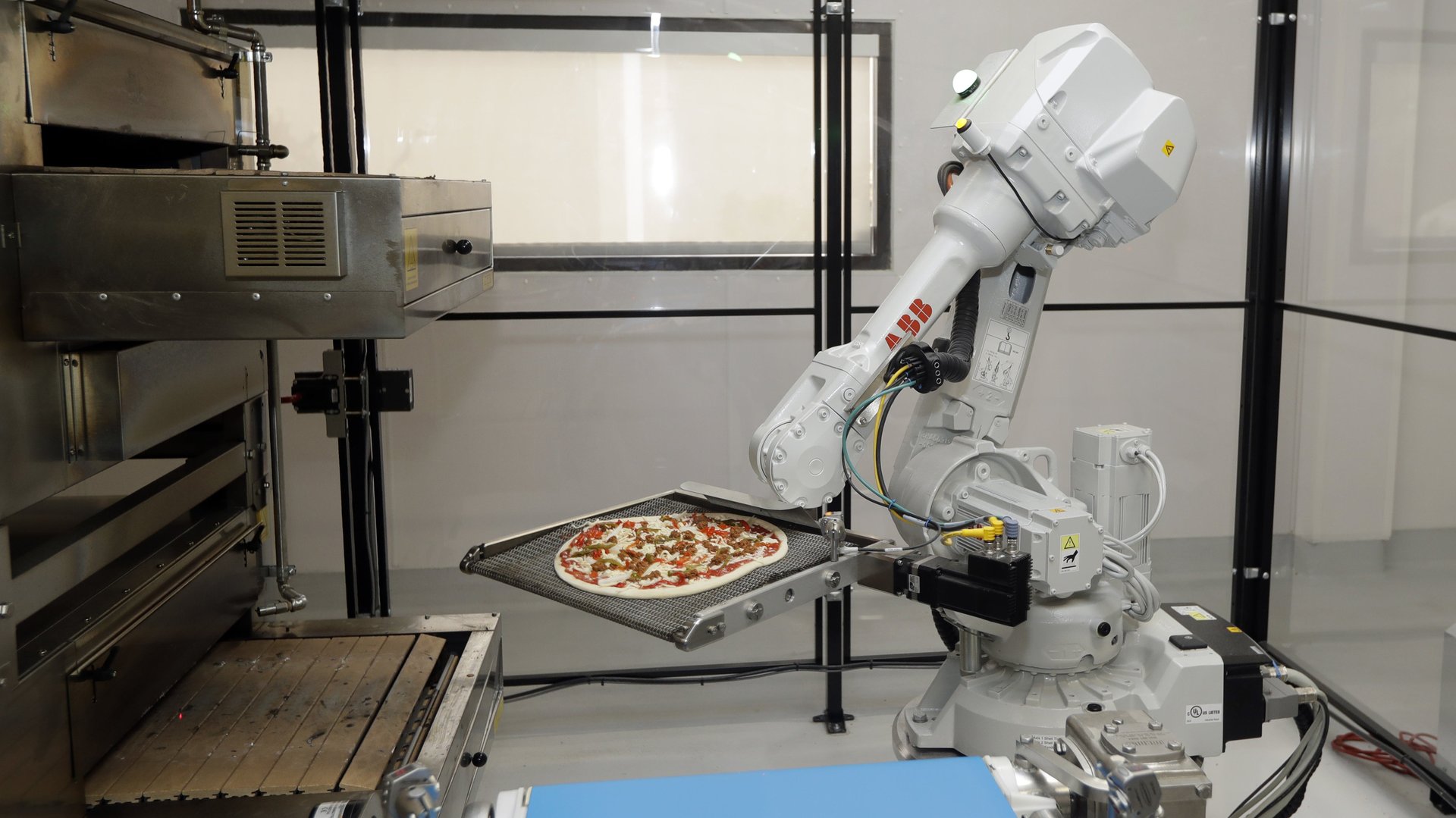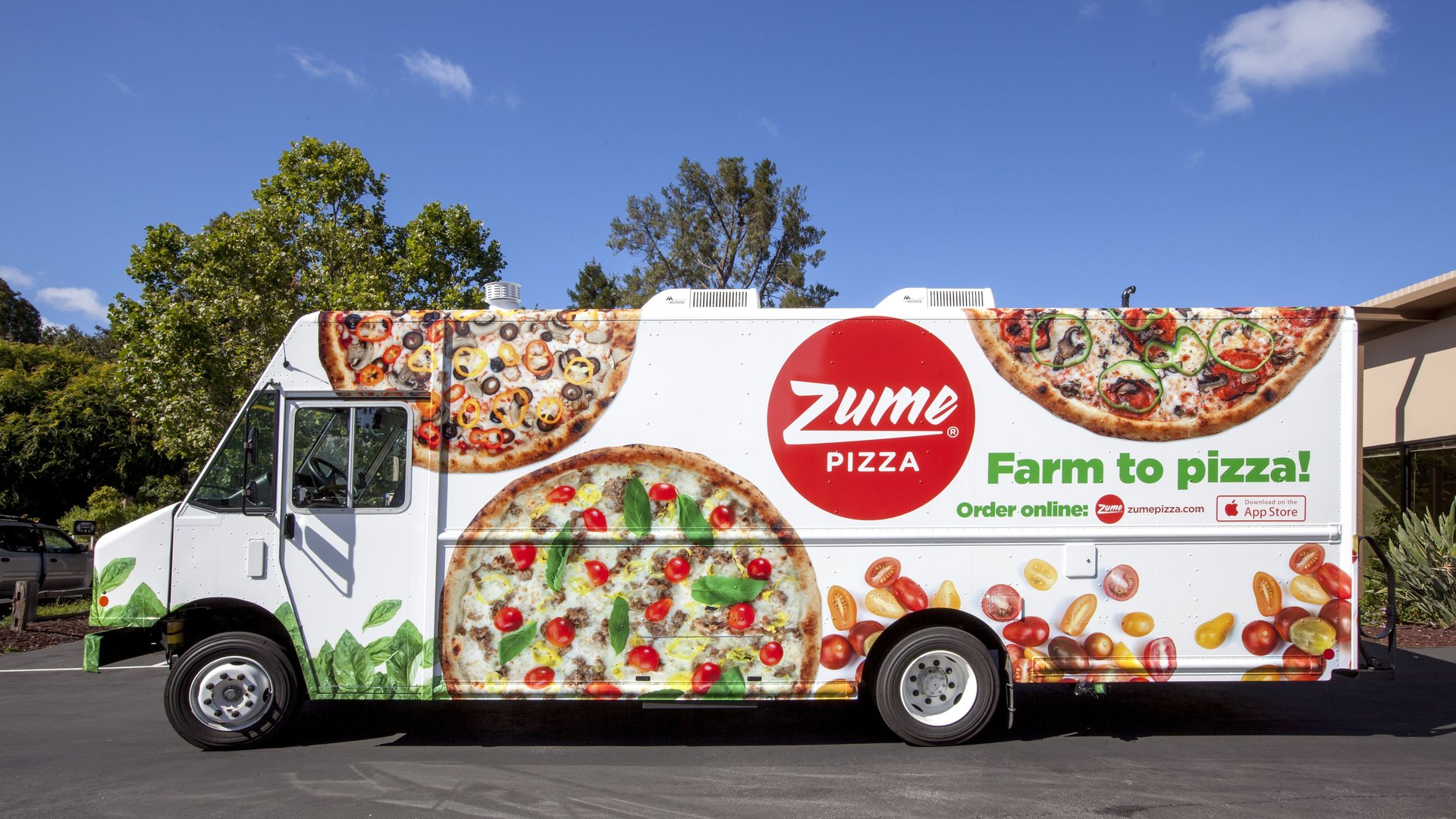An automated pizza company models how robot workers can create jobs for humans
A machine squirts sauce onto pizza dough, and a robot arm spreads it into near-perfect circles. Next, a pivoting robot shelf transfers sauced pies into 800-degree ovens. They’ll finish baking inside delivery trucks, where individual ovens sync baking times with each pizza’s destination.


A machine squirts sauce onto pizza dough, and a robot arm spreads it into near-perfect circles. Next, a pivoting robot shelf transfers sauced pies into 800-degree ovens. They’ll finish baking inside delivery trucks, where individual ovens sync baking times with each pizza’s destination.
Zume Pizza in Mountain View, California, produces more than 200 pies per day, but even during the lunch rush there are more programmers working than kitchen staff.
The startup pizza chain only needs about four people in the kitchen at a time, and if all goes as planned, that number will get even smaller. Over the next few months, the company plans to automate the beginning and end of its pizza process—tasks like pressing dough into a circle and topping pizzas with different ingredients. Eventually, Zume will only need humans to develop recipes and prepare fresh ingredients.
“It would be like Dominos without the labor component,” Zume co-founder and co-CEO Alex Garden told Bloomberg. “You can start to see how incredibly profitable that can be.”
Zume spends just 14% of what it earns in sales on payroll and benefits—Dominoes spends 30%, and McDonalds 26%—which is great, unless you happen to be a professional pizza-maker. Or one of the 12.5 million Americans employed in food preparation and service, much of which Zume believes can be automated.
One-year-old Zume is just one example of how robots and artificial intelligence are poised to automate an increasing number of routine human tasks—a reality that is predicted to impact as many as 60% of US occupations. It is also, however, an example of how the relationship between automation and jobs is complicated.
Zume uses some of the money it saves by employing fewer people to give its workers better pay: Delivery drivers make, on average $18 an hour, compared with $8 plus tips for drivers at Papa Johns, Pizza Hut, and Domino’s. All of Zume’s workers, including delivery drivers and kitchen staff, also receive fully subsidized health, vision, and dental coverage. The company even offers tuition contributions if employees want to take classes that will enable them to move around within the company as kitchen jobs become automated.
Despite these perks, Zume’s prices aren’t high. A plain 14-inch “Cheazy-E” pizza costs $15, compared with $13 for a similar pizza at a Domino’s nearby.

Labor-saving automation also allows Zume to source ingredients from nearby organic farms, even as it scales—a process that has stymied other fast-casual food chains’ attempts at local sourcing. Zume’s hope is that, as it and other automation-aided restaurants buy more ingredients locally, more such farms will open, hiring more people.
“We hope to see more growth [in high-quality food], as an industry, as a result of these [automation] companies,” says Julia Collins, Zume’s co-founder and co-CEO.
Historically, this has been the pattern of technology’s impact on job growth: Advances in automation actually increase the number of jobs in an industry by creating more positions, changing existing ones, or both. The widespread adoption of the automated power loom in the early 19th century is a classic example (and the debate around it is the origin of the term “Luddite”): Rather than resulting in widespread unemployment, which intellectuals such as Marx predicted at the time, the power loom created jobs. Every weaver could produce more cloth, which meant the price of cloth dropped. When the price of cloth dropped, demand skyrocketed, and textile shops needed more weavers to meet it.
Similarly, when bar code scanners were introduced in the 1970s, stores needed fewer cashiers on hand. But prices dropped, and the number of cashiers in the US increased by 2% on average each year between 1980 and 2013.
Some believe that advances in AI mean more jobs will be destroyed by automation today than have been in the past. When cars become driverless, for example, a broad swath of roadside services long manned by human beings can expect to see dramatic change. Likewise, the automation of white-collar jobs stands to upend a great number of industries.
“We are just seeing the tip of the iceberg,” Stanford AI professor Sebastian Thrun told the Economist, ”No office job is safe.”
Without question, automation and technology will change how people work and what type of work they do. But startups like Zume provide an important modern example of how automation can impact employment in ways that aren’t immediately apparent, or necessarily negative.
Says Collins, “I think history will ultimately prove that we’ve created more jobs in automation.”